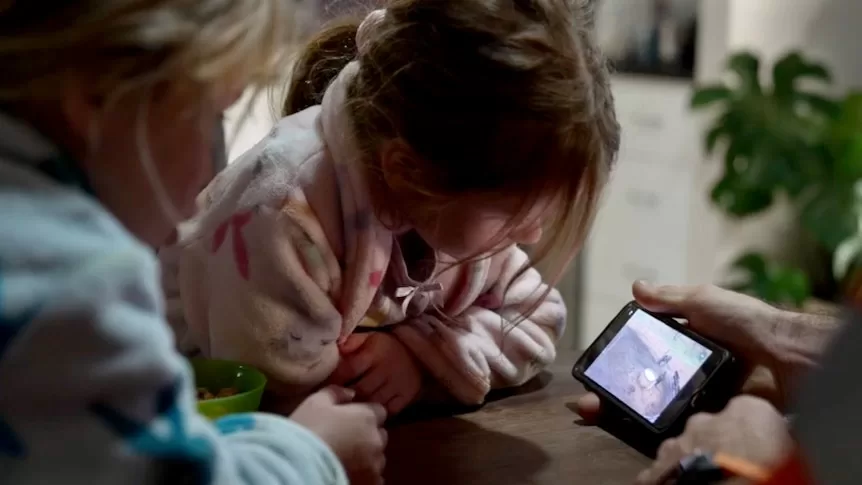It is 7am at Prenti Downs, a remote cattle station in the centre of Western Australia and Jack Carmody is checking 38 water points that are scattered across 404,685 hectares.
But he didn’t have to rush out at the crack of dawn or drive for hours — he is doing it in minutes on his phone.
By installing an intranet system, cameras and self-mustering cattle yards with gates that can be controlled remotely, he has redefined remoteness.
“Hey Google, turn on the spring gates!,” Verety, one of Jack’s three young daughters, calls out to Google Home.
“Alright, turning spring gate on,” Google replies in its feminine voice.
The girls munch on toast and Cheerios while they watch cattle moving across the screen.
Mr Carmody jokes that Prenti Downs is the biggest smart home ever and he might be right.
The technology is familiar, but it is being applied in a place that could not be more distant for most Australians.
But with a download speed that is good enough to watch the cricket and an upload speed that allows live streaming on YouTube, the internet connectivity on this remote station is better than in some suburban areas.
“We may be remote, but we are not isolated,” Jack says with a smile.
‘Makes business sense’
Constant access to visual data allows Mr Carmody more time to spend improving his business and being with his young family.
It also saves him more than $2,000 a week in travel, vehicle maintenance and labour.
“It has to happen,” Mr Carmody says.
“It just makes business sense.”
It makes sense in other ways, too — Mr Carmody can constantly track cattle, target feral animals and reduce grazing pressure as required, which allows perennial grass to grow.
“You identify issues quickly, because we have our eyes on them all the time, and more sets of eyes on one location,” Mr Carmody says.
He just got off the phone with his dad, who spotted a leaking trough on the station while looking at CCTV footage from his property on the south coast.
But beyond leaking troughs and camel incursions, remote monitoring and reliable internet connections are keeping people safer.
The Carmodys’ closest neighbours, who live in the Aboriginal community of Cosmo Newbery and on Windidda Station, know they can connect to the internet when they travel through Prenti Downs.
“We’d like to get that happening on Windidda,” says Regina Ashwin, a Martu woman whose family manages station.
“If family go out bush and if we break down or something, at least we can have connection to call someone if it’s an emergency.”
It was thanks to the cameras that Ms Ashwin’s cousin got the help he needed – and a hot breakfast – when his car broke down on Prenti.
Artefact ‘treasure map’
But not all people travelling through the remote station appreciate the level of surveillance.
Cameras pointing toward an Aboriginal cultural site on Prenti Downs were found with their cables neatly disconnected.
Mr Carmody said by making the location of heritage sites easy to find online, the West Australian government had inadvertently created a “treasure map” accessible to all, including artefact hunters.
“Because there’s no surveillance on them, people think they can go in and steal themselves a bit of history,” he said.
Cameras have deterred artefacts hunters on Prenti, trespassers have disturbed culturally sensitive sites on other stations.
“Sometimes we have people coming out there without notifying us, and they do go to certain areas they are not supposed to be, and we don’t see that until later,” Ms Ashwin said.
“Makes me feel angry, cos it’s just the same as someone breaking into your backyard or house.”
The technology Mr Carmody uses is helping protect to the past as well as preparing the industry for the future.
He says artificial intelligence has the potential to improve data-driven decisions and track animals over time.
If more stations were to adopt a similar system, the data gathered could be shared and analysed at a broader spectrum through similar areas.
“We could make decisions months in advance with good seasonal outlook,” Mr Carmody said.
“It’s working smarter, not harder.”
New light, old windows
With the exception of one “burning catastrophe”, when a unit being tested overheated, Mr Carmody said the intranet and remote surveillance, which he installed himself, worked.
“It’s shining new light through old windows,” he said.
He says many pastoralists have expressed an interest in adopting the same system, but connectivity has been an issue.
The cost of the investment stops some, but the main barrier is a lack of confidence in technology.
When the neighbouring station applied for funding to set up an intranet and remote surveillance system, it was rejected.
“The assessment panel said it was not technically feasible, despite having a pilot program with remote wireless gates and an 80-kilometre range,” Mr Carmody said.
Given the potential of the technology, he said there was a “concerning” lack of support from the industry.
“I’m talking about the supporting sides of it, such as from the government through grant programs, outreach programs and also just training, to teach people they can do it,” Mr Carmody said.
‘Two-way conversation’
The internet connects the Carmodys to the outside world and allows the outside world to look in.
Mr Carmody’s YouTube channel, on which he shares his work at Prenti Downs, was started as part of a competition with his cousin over who could get the most followers.
It gave him followers from all around Australia and the world, but it also gave him a tool to educate others and himself.
Mr Carmody regularly receives useful feedback from experts from other industries.
“It’s a two-way conversation” he said.
“One of the most valuable assets to the pastoral industry is an outside set of eyes.”
Stories from farms and country towns across Australia, delivered each Friday.
